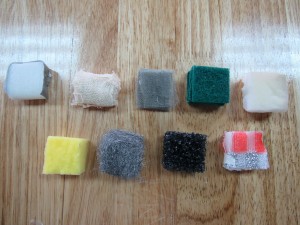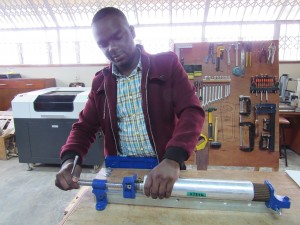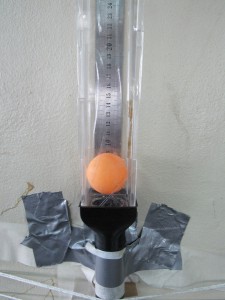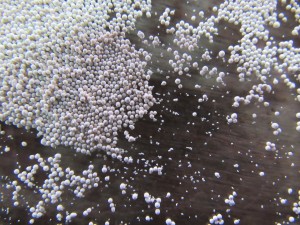After travelling to several small hardware and household supply stores in Limbe, we selected eight locally available filter materials: thin foam, cloth, wire mesh, a green scrubbing sponge, thick foam, a standard yellow sponge, steel wool, and a sponge covered in cloth.
 The eight filter materials cut for testing in addition to a NewLife Intensity filter
The eight filter materials cut for testing in addition to a NewLife Intensity filter
Though we struggled to create accurate testing set-ups using available resources for a while, we came up with a simple ping pong ball airflow test and a dirt retention test using weight measurements before and after a set amount of dirt was sucked through the filters with a vacuum. Our goal was to compare the performance of each material to the performance of the NewLife Intensity (an oxygen concentrator model) filter. We used our results as well as a wash test, drying time, cost, availability, and ease of use to select the winning filters: the yellow and green sponges.
Our airflow test set-up (the filter is inside of the black adapter)
As far as sieve bed regeneration goes, we bought a clamp that makes opening the sieve beds much easier and therefore much more feasible.
 Vincent opening a sieve bed with the clamp
Vincent opening a sieve bed with the clamp
By contaminating sieve material with water and measuring it’s performance in a concentrator before and after regeneration we were able to prove that our oven method can bring the output oxygen concentration from 39% back up to 80%. Unfortunately, this is still considered below optimal output. We think that this could be due to several factors. First of all, we are testing on a concentrator that had been broken for years already, so we think there may be some other points of failure contributing to the low output. Also, we noticed some fine dust in the sieve material that should be removed for optimal performance.
Dust among the spherical zeolite
We have also worked on creating an intake filter and our education project, which you will find more about in later blogs. As the end nears, I feel like there is so much more we could do with more time. However, our work has had much more depth than just a couple of simple projects. We are making a big effort to set up projects in such a way that they will be easily picked up again by others. Though the biomedical engineering program at the Poly is new, the interns we’re working with are electrical and mechanical engineers who have really enjoyed all of the work we’ve done together. The relationships forged between the hospitals and the Polytechnic are key for future collaboration on projects, which I’m confident will continue to grow in frequency in the coming years.

